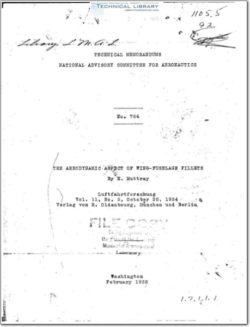naca-tm-764

- Version
- 234 Downloads
- 1.52 MB File Size
- 1 File Count
- April 23, 2016 Create Date
- April 23, 2016 Last Updated
National Advisory Committee for Aeronautics, Technical Memorandum - The Aerodynamic Aspect of Wing Fuselage Fillets

Model tests prove the feasibility of“ enhancing the
aerodynamic qualities of wing—fuselage fillets by appro~
priate design of fuselage and wing roots. Abrupt changes
from maximum fuselage height to wing chord must be avoided a
and every longitudinal section of fuselage and wing roots ' M
must be so faired and arranged as to preserve the original '
lift distribution of the continuous wing. Adapting the 1
fuselage to the curvilinear circulation of the wing affords a 5
further improvement. The polars of such arrangements are N
almost the same as those of the "wing alone," thus voiding g
the superiority of the high—wing type airplane known with
the conventional design. Besides, protuberances such as
Windshields, etc., disturb the aerodynamic quality of a
mid wing or low wing less than of a high wing, so that the
latter actually becomes inferior by comparison.
For reasons of an appropriate aerodynamic and static
combination of wing and fuselage, the further development
of high—performance gliders should be carried on with mid—
wing type monOplanes.
The accepted method of raising the performance of
gliders in past years has been to increase the wir g Span.
But lately this practice has fallen into disuse after it
was found that a large span entailed certain disadvantages
which seemingly made this avenue of attack rather unad~
Vised.
The attention of the designers was turned to other
means for promoting higher flight performances.
here is, for example, the method of fairing the wing
into the fuselage and Of housing the pilot within a cabin~‘
like enclosure. Both of these methods are intimately re—
lated ins.9far as the. complete enclosure- of t-he pilot- must
precede any aerodynamically favorable wing~fuselage combi~
nation. In point of fact, it was this very method of
pilot—seat enclosure resorted to within the last few years,
which really caused the renewed drive for wing fillets;
Hereinafter is the description'of an essentially ex~
perimental investigation of wing fillets and various de—
ductions.
| File | Action |
|---|---|
| naca-tm-764 The Aerodynamic Aspect of Wing Fuselage Fillets.pdf | Download |
Comment On This Post